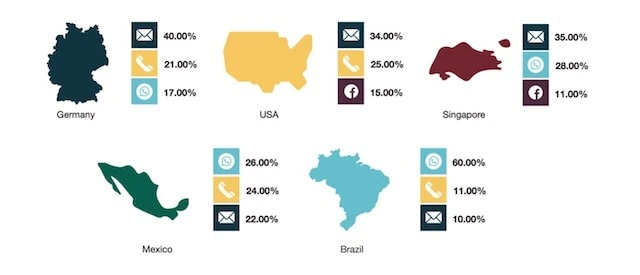

Social media customer service defined
Social media has evolved into a platform shared by the personal lives of individuals and companies that want to get their business. Today, consumers want the simplicity of reaching any given business on the appropriate platform(s). Businesses reach these expectations by incorporating their customer support team into social media platforms. This is social media customer service, providing customer support through your social media channels.
Learn why having customer support integrated into social media is so important to stay competitive, how to implement social support in your business workflows, the criteria for the right social media customer support tools, and how to measure your successes.
On which social media channels should businesses offer customer support?
Facebook, YouTube, WhatsApp, Instagram, Facebook Messenger, Weixin/WeChat, TikTok, and the list goes on! You may find your team questioning if you must monitor every app constantly; the answer is no.
Consumer Reports found that users are more likely to complain on the platforms they are most active on. So, find out where your target audience is and make your brand present on those applications.
Why social customer service matters
Customers are all over social media
Faster and more convenient, or we’re done – this is the atmosphere of the technology world today, and that’s just what people get when using social media. Engagement is key to gaining trust on social media. Customers long to be close to your brand; they want to engage with you to get help, get questions answered, and converse with your brand.
The rise of conversational business is changing social media business platforms from strictly marketing & advertising channels to now including a customer support channel.
People are on social media all day, every day. Brands must go where the people are.Abdul Muhammad, Chief Digital Officer & Partner at RBB Communications
Exceeded customer expectations
There are several reasons businesses around the world are making sure they are providing their customers with social customer care. Customers are the source of your revenue and caring about their customer experience (CX) will grow your business. But how exactly will social media customer support positively affect the customer’s journey?
Here are some statistics on social media customer service and how it relates to satisfying the customer:
- 1 billion messages between businesses and people on Facebook Messenger, and 73% of these users trust a brand more when messaging them (Meta)
- When customers receive a response, they are willing to spend 3-20% more on that business (Twitter)
- 9% of businesses don’t respond to comments on Instagram and 16% of businesses don’t respond to comments on Facebook (Gartner)
Seamlessly providing customer support wherever the customer is is the goal; this is called omnichannel communication. Based on an OTRS study about what leaders are doing in customer service, notice that all countries are providing customer support on at least one social media platform:

Use of communication channels per country in percent
How to use social media for customer service
Get started with implementing the right tools for social media customer support
There are a lot of tools out there for managing social media, whether it’s an all-in-one solution or a product tailor-made for you and your team.
The ideal social media customer support tool will manage email support and social media conversations. It is a bonus if it also lets you handle phone and live chat inquiries and if it uses KBAs for providing faster information to customers. These tools should help you and your agents get response time down to a minimum and flag urgent tasks, ensuring each case is delivered to and handled by the right person every time.
Manage your customer’s expectations by making it very clear when your customer service team is available and how long they usually take to respond. Using text templates and automatic replies saves your agents time by providing a standard for CS.
Incorporate social media as a part of your customer service protocol – actively listen
Customers are constantly telling you what they want, need, like, or dislike – just listen! But listen and respond with a purpose. Since social media will now be a part of your customer service process, each customer interaction should have a standard protocol.
Active listening starts with having a team that monitors social media platforms for customer service opportunities; this is called social listening. During Hootsut’s 2022 Social Media Trends survey, almost two-thirds of respondents agreed that social listening increased the value of the organization on platforms within 12 months.
Customers want to see consistent customer care on all platforms of a business. Active listening is showing empathy through text, just like how you would talk to somebody. Phrases like:
- “Wow! That must be so…”
- “I understand how you feel…”
- “I felt that way too…”
- “Let me see if I’m understanding correctly…”.
Using first names when addressing customers and signing off are some great ways to personalize an interaction. Also, avoid negative phrases and words like; unfortunately, calm down, actually, and no.
Show your customers you care by collecting feedback, analyzing the responses, and responding accordingly
The answer is in the data; using the right metrics to keep track of your customers is the biggest step. Using solutions like customer service software helps managers easily keep track of all these measurements.
Key performance indicators or KPIs, help managers understand what is working in your current process and where they can improve. These measurements branch into two categories to understand where the gaps are in the business’s sales process. The operational data (O-data) comes from the number of new customers, website visitors, call center volumes, sales figures, etc. Then, experience data (X-data) shows how your customer feels about the brand and whether will they buy again.
Customer service metrics to measure
Here are 13 customer service KPI metrics that matter when collecting feedback from your customer service team:
- Customer Satisfaction (CSAT): measures the customer’s experience with support
- Customer Effort Score (CES): measures how much effort a customer puts forth to resolve an issue
- Net Promoter Score (NPS): measures how likely a customer will recommend your business
- Customer Churn: number of customers who fail to become repetitive customers
- Response Time: the median amount of time it takes to respond to a customer
- First Response Time: how long it takes for a customer to get an initial reply from support
- Overall Resolution Rate: the median amount of time it takes to completely resolve a customer request
- First Contact Resolution Rate: percent of tickets where your agents resolve a request within a single response
- Ticket Volume: total number of conversations in your support inbox
- Ticket Backlog: tickets that are left unresolved
- Average Ticket Handling Time: measures how long it takes an agent to receive and reply to a customer request
- Replies Per Resolution: measures how many times an agent and customer communicate back and forth per ticket
Use the data!
Take advantage of your customer service metrics. Collecting this data will do nothing for your business or customer experience if you don’t use it. Based on each KPI, figure out your next course of action and learn what works for you and your team.
Improve your Customers’ Experience with a Structured Solution
Ready to get started with preconfigured customer service software? Try OTRS. A customer service software solution is used by the whole team – customers, agents, and management – to increase revenue and strengthen the customer-business bond. Learn more about the benefits and features this solution can offer you here.
Categories
- About OTRS Group (21)
- Automation (3)
- Corporate Security (26)
- Customer Service (30)
- Developing a Corporate Culture (12)
- Digital Transformation (54)
- General (86)
- ITSM (36)
- Leadership (22)
- OTRS in Action (8)
- Processes (5)
- Using OTRS (15)
